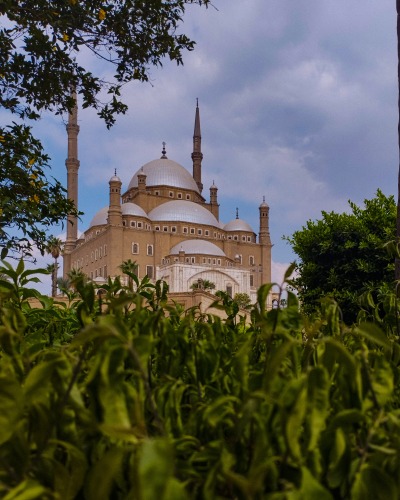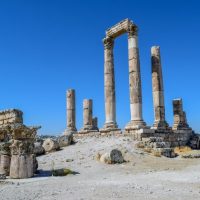Egypt is no stranger to beautiful castles, with a number of astounding structures that are sure to take visitors’ breath away.
This nation’s lengthy military history would indicate that there will be no shortage of castles for visitors to take in and this guide goes a long way towards explaining the best locations.
There is a wide range of iconic castles in Egypt and these paradises are best experienced in person.
To learn more about each of these castles and the amenities that they have to offer, please be sure to check out the following guide.
Contents
The Citadel of Salah El-Din
This Islamic-era fortification is located in Cairo and was constructed back in 1176.
The castle served as a way to protect the Egyptian city from its enemies and subsequent rulers continued to add to the structure.
It’s a very intriguing structure from an aesthetic standpoint as well, as it has been built into the side of a hill and spans four floors across one of the city’s highest plateaus.
From the 13th to 19th centuries, it served as the government seat for Egypt.
Rulers of the nation resided here for 700 years.
Nowadays, public visitors flock from all over the world.
The historical military museum and the Great Mohamed Ali mosque are favored attractions, as visitors are given the chance to check out miles’ worth of passageways and chambers.
Shali Castle
Located in Siwa, this castle looks like something out of a dream.
It’s a stunningly unique archaeological site that has to be seen to be believed.
If you have ever seen it for yourself, it resembles an enormous sand castle.
Thanks to the Shali Fortress and Village Initiative in the Siwa Oasis, the castle has been restored and local tour guides are more than happy to help you explore.
The native Berbers and/or Imazighen community are believed to be responsible for the castle’s initial construction.
The material that was used to create the Shali Castle allows for its unique appearance.
The mixture is known as “salty kershef“, which is comprised of mud, salt, and minerals that have been derived from the nearby Siwan salt lake.
Saladin Castle
Those who are fascinated with the ruins of Ayyubid, Abbasi, Crusades, and Mamluk will find much to enjoy when they visit Saladin Castle in Sinai.
Outside of Cairo, this is the most well-preserved Ayyubid Castle from ancient times.
The structure dates all the way back to 1116 AD and served as one of the most crucial stops on the Egyptian trade route of the time period.
It’s a common destination for those who are visiting the Egyptian city of Taba.
The castle itself is located atop a sandy island that can be reached with a simple day trip.
There are all sorts of affordable hotels in the area so that visitors are able to spend the day and tour the castle.
Castle Zaman
This castle was built in modern times and has been designed to mimic the designs of medieval times.
When you arrive here, you are treated to the sort of views that few other locations can match.
The mountains of Sinai are behind you, while the Red Sea is in front.
Zaman means “castle of the past” in Arabic and Hani Roshdi’s love for medieval architecture shows.
He completed the structure in 2003.
No steel or concrete has been included in the construction of this castle and the attention to detail is on full display.
These tours have become very popular and visitors are advised to arrive as early as possible so that they are able to beat out the initial rush.
Bab Zuwelia
The Cairo gate of Bab Zuwelia has been in existence for over a thousand years now.
During the Ottoman period, it was also known by the name Bawabbat al-Mitwali.
It is one of the final remaining gates at the Old City of Cairo, the Egyptian capital.
When the vizier of the time period had a second wall built around the city, Bab Zuwelia became the southern gate.
The twin towers at Bab Zuwelia can still be accessed, although the climb is steep.
Executions were once performed on the Bab Zuwelia platform as well.
Visitors can still visit this historical landmark, as there are a couple of different tours to choose from.
Some may select the half-day tours or the full-day tours of Cairo, depending on their personal interest levels.
Bab al-Fatuh
To build on the previous entry, Bab al-Fatuh is another one of the aforementioned three walls that were constructed around the city of Cairo.
The vizier Badr al-Jamali is responsible for the construction of this wall, which took place during the Fatimid imam-caliph Mustansir’s reign.
Shafts were provided so that boiling hot water could be poured onto attackers and arrow slits were also created.
Much like Bab Zuwelia, Cairo visitors will have every opportunity to check out this gate if they are so inclined.
Half-day and full-day tours are offered.
Bab al-Fatuh is especially fun to check out, especially for those who are able to appreciate the geometric and vegetal motifs that this gate has to offer.
Syrian stone was used to craft the gate as well.
Musafirkhana Palace
This palace was constructed in the Ottoman style between the years 1779 and 1788.
The khedive Ismail was born here in 1830.
Muhammad Ali Pasha then purchased the palace during the early 19th century, with the intention of using it as a guesthouse.
Nowadays, it is used for a wide range of different purposes.
Workshops are often held in the palace and artists will utilize them for housing purposes.
The structure was designed to emulate the Bayt Suhaymi, only on a far grander scale.
The interior is a sight to behold, with a carved ceiling, an inlaid fountain, and a well that was once powered by donkeys on the first floor.
The marbled panels on the second floor are also sure to catch the eyes of many visitors.
Abu Qir Castle
This castle serves a unique purpose in Egyptian history, having served as a prison during the 19th-century reign of Muhammad Ali.
It is located in Alexandria Governorate, Egypt in Abu Qir town.
During the time period, the prison was actually known as Liman Abu Qir.
Visitors are more than welcome to check out the location for themselves.
What it may lack in traditional beauty, it more than makes up for with its rich history.
It is an especially common location for history buffs who are looking to learn more about the social history of this particular Egyptian region.
Those who wish to study the reign of Muhammad Ali will also find this to be a location of interest.
Newibah Castle
This castle was originally constructed beneath the ancient ruins of an already fallen structure.
Its construction can be traced all the way back to the Ayoubid period, back in 1893.
The southern section of the previous castle was used as a starting point.
These blocks were utilized in the building of the outer wall, where openings for war were also created.
The shaft in this castle is still used in the present day.
There are also some chambers. It has its own fresh water well and was once used as a police guard station.
Nuweiba, as the city is known today, is a common stop for travelers in the region.
Whether you would prefer to engage in some more typical tourist activities or explore the secrets that the desert has to offer, Newibah Castle is a must-see.
Babylon Fortress
The Babylon fortress may look like something out of a movie, but it is real and spectacular.
The ancient castle is located in Coptic Cairo and is well worth a visit.
It was constructed during the Roman period, in the 2nd century AD.
Old Cairo visitors can even learn more about the amazing history of this structure, which was originally constructed to house prisoners at the end of a war.
Once the prisoners were able to seize control of the area, the name was then changed to Babylon.
The fortress is said to have been built by Nebuchadrezzar, who was the king of Babylon during this time period.
In the present day, visitors are more than welcome to purchase a ticket and check out the fortress in person.
It is an amazing achievement, from both an architectural standpoint and a triumph of the human spirit.
Egypt Safety Overview
READ THE FULL REPORT: Egypt Safety Review
Safety Index:
- OVERALL RISK: MEDIUM
- TRANSPORT & TAXIS RISK: MEDIUM
- PICKPOCKETS RISK: HIGH
- NATURAL DISASTERS RISK: MEDIUM
- MUGGING RISK: MEDIUM
- TERRORISM RISK: HIGH
- SCAMS RISK: HIGH
- WOMEN TRAVELERS RISK: HIGH
Frequently Asked Questions
Why Was Egypt Considered To Be So Advanced?
These structures lead many to wonder how Egypt managed to remain so advanced for so many centuries.
For starters, Egypt was home to one of the world’s oldest literate societies, which paid huge dividends from an architectural standpoint.
Since much of the population was involved in agriculture, it was easy to motivate this centralized workforce to take on architectural projects during the months when the Nile River flooded.
What Is The Best Time of Year To Visit Egypt?
The last thing that a visitor will want to deal with is the scorching desert climate that can make the hotter months quite unbearable.
That’s why experts will suggest that visitors schedule their trips to Egypt during the months of February to April.
The months of October and November are also more moderate from a climate standpoint.
The months of June to August, on the other hand, should be avoided at all costs.
What About The New Capital City?
Egyptian President Abdel Fatah al-Sisi has elected to construct a new capital, but the process has yet to be completed.
The New Administrative Capital, as it is currently known, is part of a grander initiative known as Egypt Vision 2030.
A proper name has yet to be chosen and a completion date has yet to be set.
What’s Egypt’s Most Recognizable Monument?
Outside of the many castles and fortresses that were constructed during this time period, the Great Pyramid of Giza stands as a towering achievement to this day.
Standing 146 meters high, this pyramid was the largest human-built structure in the world until 1889.
The title was eventually lost to the Eiffel Tower.











